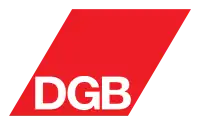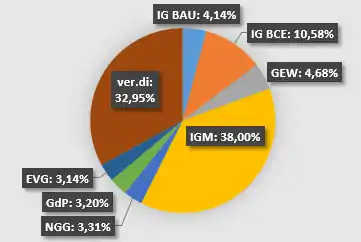German Trade Union Confederation
The German Trade Union Confederation (German: Deutscher Gewerkschaftsbund; DGB) is an umbrella organisation (sometimes known as a national trade union center) for eight German trade unions, in total representing more than 6 million people (31 December 2011). It was founded in Munich, 12 October 1949.
 | |
| Full name | German Trade Union Confederation |
|---|---|
| Native name | Deutscher Gewerkschaftsbund |
| Founded | 12 October 1949 |
| Predecessor | General German Trade Union Federation |
| Members | 6.0 million |
| Affiliation | ITUC, ETUC, TUAC |
| Key people | Reiner Hoffmann (SPD), president |
| Office location | Berlin, Germany |
| Country | Germany |
| Website | www.dgb.de |
The DGB coordinates joint demands and activities within the German trade union movement. It represents the member unions in contact with the government authorities, the political parties and the employers' organisations. However, the umbrella organisation is not directly involved in collective bargaining and does not conclude collective labour agreements.
Union delegates elect committees for 9 districts, 66 regions and the federal centre. The organisation holds a federal congress every four years. This assembly sets the framework for trade union policies and elects five Federal Executives. Together with the presidents of the member unions they constitute the DGB's executive committee. The members of the executive committee, together with the DGB regional presidents and 70 delegates from the unions, form a Federal Council which meets once a year to make decisions on national issues. The DGB also has a youth organisation, DGB-Jugend.
The DGB has its headquarters in Berlin. It is a member of the European Trade Union Confederation (ETUC) and the International Trade Union Confederation (ITUC).
History
Until 1933
As first German confederation of unions at 14 March 1892 the Generalkommission der Gewerkschaften Deutschlands was founded in Halberstadt. It represented 57 national and some local unions with approximate 300,000 people in total. After World War I unions had to reorganise. During a congress in Nuremberg from 30 June until 5 July 1919 the Allgemeiner Deutscher Gewerkschaftsbund (ADGB) was founded as an umbrella organisation of 52 unions with more than 3 million members. The ADGB may be seen as predecessor of today's DGB. Like today, there also existed a conservative counterpart of lesser importance. Curiously, this conservative organisation was named Deutscher Gewerkschaftsbund, DGB. On 2 May 1933 all trade unions were dissolved by the Nazis.
1946–1949
After World War II German unions had to reorganize once again.
On 9–11 February 1946 the Freier Deutscher Gewerkschaftsbund (FDGB) was founded in Berlin as a confederation of 15 unions in the Soviet occupation zone.
On 23–25 April 1947 the Deutscher Gewerkschaftsbund, DGB was founded in Bielefeld as a confederation of 12 unions in the Allied-occupied Germany.
Foundations in the American occupation zone:
24/25 August 1946: Freier Gewerkschaftsbund Hessen
30 August – 1 September 1946: Gewerkschaftsbund Württemberg-Baden
27–29 March 1947: Bayerischer Gewerkschaftsbund
Foundations in the French occupation zone:
15/16 February 1947: Gewerkschaftsbund Süd-Württemberg und Hohenzollern
1/2 March 1947: Badischer Gewerkschaftsbund
2 May 1947: Allgemeiner Gewerkschaftsbund Rheinland-Pfalz
On 12–14 October, the 7 umbrella organisation in West Germany merged into the West German DGB as a confederation of 16 single trade unions.
| Allgemeiner Gewerkschaftsbund Rheinland-Pfalz | 232,117 | |
| Badischer Gewerkschaftsbund | 92,257 | |
| Bayerischer Gewerkschaftsbund | 815,161 | |
| DGB of the British zone | 2,885,036 | |
| Freier Gewerkschaftsbund Hessen | 397,008 | |
| Gewerkschaftsbund Süd-Württemberg und Hohenzollern | 75,502 | |
| Gewerkschaftsbund Württemberg-Baden | 464,905 | |
| Total | 4,961,986 |
Reunification – Present
In 1990, the members of the FDGB of the German Democratic Republic joined the members of the DGB. In recent years, many member unions of the DGB have merged, so today the DGB has only 8 members. This was seen as a progress by many unionists who hoped for stronger representation, while others claim that strong member unions like ver.di with its two million members have considerably weakened the DGB as a roof organization.[1]
In general, the influence of German trade unions has declined since 1990 and had to accept shrinking real incomes and a reform of the welfare system in 2004 ("Hartz IV laws"), which put additional pressure on wages. For some years, the DGB and its member unions have been campaigning for a minimum wage to be introduced in Germany. Well into the 1990s, they had rejected this idea because they got better results from their strong position in the German system of collective bargaining.[2]
Affiliates
Today
| Members of DGB unions 2017[3] | |||||||
|---|---|---|---|---|---|---|---|
| Union | Women | Men | In total | ||||
| IG Bauen-Agrar-Umwelt (Construction, Agriculture, Environment) | IG BAU | 67,069 | 26.35% | 187,456 | 73.65% | 254,525 | 4.25% |
| IG Bergbau, Chemie, Energie (Mining, Chemicals, Energy) | IG BCE | 137,012 | 21.49% | 500,611 | 78.51% | 637,623 | 10.64% |
| Gewerkschaft Erziehung und Wissenschaft (Education and Science) | GEW | 199,529 | 71.71% | 78,714 | 28.29% | 278,243 | 4.64% |
| IG Metall (Metalworkers) | IGM | 406,893 | 17.98% | 1,855,768 | 82.02% | 2,262,661 | 37.74% |
| Gewerkschaft Nahrung-Genuss-Gaststätten (Food, Beverages and Catering) | NGG | 83,741 | 41.89% | 116,180 | 58.11% | 199,921 | 3.33% |
| Gewerkschaft der Polizei (Police) | GdP | 46,032 | 24.86% | 139,121 | 75.14% | 185,153 | 3.09% |
| Eisenbahn- und Verkehrsgewerkschaft (Railway Workers) | EVG | 41,204 | 21.69% | 148,771 | 78.31% | 189,975 | 3.17% |
| Vereinte Dienstleistungsgewerkschaft (United Services Union) | ver.di | 1,038,221 | 52.24% | 949,115 | 47.76% | 1,987,336 | 33.15% |
| DGB in total | DGB | 2,019,701 | 33.69% | 3,975,736 | 66.31% | 5,995,437 | 100.00% |
 | |||||||
Former affiliates
| Union | Acronym | Year merged | Merged into |
|---|---|---|---|
| German Railwaymen's Federation | GdED | 2010 | EVG |
| Textile and Clothing Union | GTB | 1998 | IGM |
| Wood and Plastic Union | GHK | 2000 | IGM |
| Building and Construction Union | IG BSE | 1996 | IG BAU |
| Horticulture, Agriculture and Forestry Union | GGLF | 1996 | IG BAU |
| Union of Mining and Energy | IG BE | 1997 | IG BCE |
| Chemical, Paper and Ceramic Union | IG Chemie | 1997 | IG BCE |
| Leather Union | GL | 1997 | IG BCE |
| German Postal Union | DPG | 2001 | Ver.di |
| Trade, Banking and Insurance Union | HBV | 2001 | Ver.di |
| Public Services, Transport and Traffic Union | ÖTV | 2001 | Ver.di |
| Printing and Paper Union | DruPa | 1989 | IG Medien |
| Arts Union | Kunst | 1989 | IG Medien |
| Media Union | IG Medien | 2001 | Ver.di |
Other unions
In 1978 the Gewerkschaft der Polizei (GdP, see above) joined the DGB as 17th union.
The Deutsche Angestellten Gewerkschaft – DAG – was a large white collar trade union.
Although the DAG in the British zone 1946 was a member of the DGB in the British zone,
the West German DAG never joined the West German DGB as a single member union.
But in 2001 the DAG merged with four existing DGB unions to become the new DGB union ver.di.
The railway unionVerkehrsgewerkschaft GDBA was a member of the German Civil Service Federation.
In 2010 the GDBA merged with existing DGB union TRANSNET to the new DGB union EVG.
Presidents
- 1949: Hans Böckler
- 1951: Christian Fette
- 1952: Walter Freitag
- 1956: Willi Richter
- 1962: Ludwig Rosenberg
- 1969: Heinz Oskar Vetter
- 1982: Ernst Breit
- 1990: Heinz-Werner Meyer
- 1994: Dieter Schulte
- 2002: Michael Sommer
- 2014: Reiner Hoffmann
Structure
districts with regions
- Baden-Württemberg: 4 regions
- Bayern: 14 regions
- Berlin/Brandenburg: 4 regions
- Hessen/Thüringen: 6 regions
- Niedersachsen/Bremen/Sachsen-Anhalt: 10 regions
- Nord (Niedersachsen/Bremen/Sachsen-Anhalt): 7 regions
- Nordrhein-Westfalen: 11 regions
- Sachsen: 4 regions
- West (Rheinland-Pfalz/Saarland): 6 regions
See also
- List of labor unions
- Hans Böckler - first president of the confederation
Literature
- ICTUR; et al., eds. (2005). Trade Unions of the World (6th ed.). London, UK: John Harper Publishing. ISBN 0-9543811-5-7.
- F.Deppe/G.Fülberth/H.J.Harrer: Geschichte der deutschen Gewerkschaftsbewegung ISBN 3-7609-0290-1
- http://www.dgb.de/uber-uns/dgb-heute/
External links
| Wikimedia Commons has media related to Deutscher Gewerkschaftsbund. |
References
- Hans-Otto Hemmer: Nur noch ein Restposten? – 60 Jahre DGB, in: Jahrbuch für Forschungen zur Geschichte der Arbeiterbewegung, No. III/2009.
- See also Hemmer 2009.
- "DGB-Mitgliederzahlen 2010-2018".